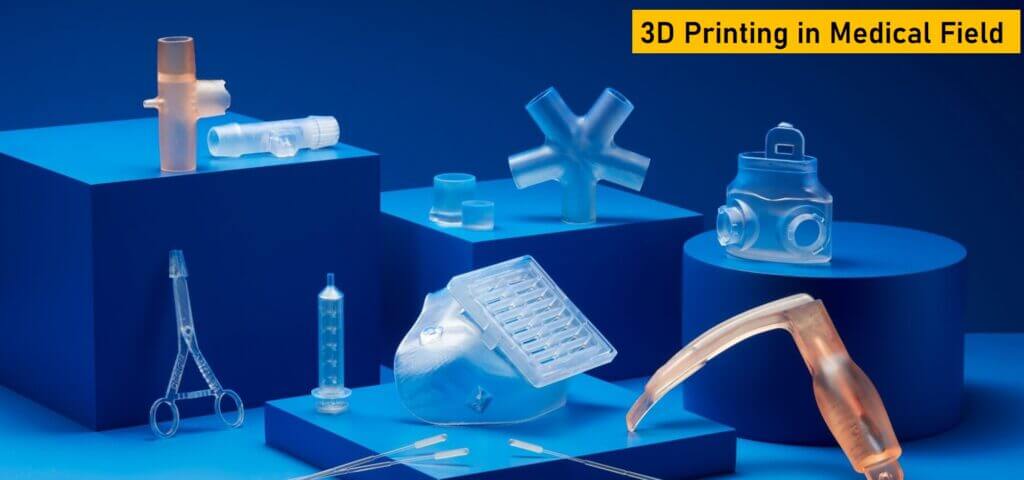Industry 4.0 technologies have already started disrupting and transforming many industries, including healthcare. Companies and startups in the healthcare industry leverage various cutting-edge technologies to change the detection and treatment of diseases. But they use each of these technologies for specific purposes.
Additive manufacturing or 3D printing is one of the Industry 4.0 technologies driving the digitalization and transformation of healthcare. In addition to facilitating personalized medical service delivery, medical 3D printing technologies create opportunities for the manufacturing of next-generation medical equipment and drug.
At present, the applications of 3D printing in the medical field range from clinical healthcare activities to healthcare research and development (R&D). Also, new use cases of medical 3D printing are being created regularly by medical practitioners and medical researchers. We can assess the growing significance of 3D printing in medical fields based on some of these use cases or applications.
7 of the Major Applications of 3D Printing in the Medical Field
Patient-Specific Organ Replicas
While planning complicated surgeries, medical practitioners have to focus on reducing operation time and post-operative trauma simultaneously. They explore ways to practice surgical techniques before performing the operation.
3D printing technologies enable surgeons to practice and evaluate techniques using patient-specific organ replicas. 3D printers produce these organ replicas by mimicking the mechanical properties of the original organ.
Medical practitioners use 3D printers to produce replicas of specific body parts and whole organs. Access to 3D-printed models makes it easier for doctors to perform complicated operations safely and efficiently.
Personalized Prosthetics
As artificial body parts, prosthetics restore the function and appearance of body parts lost due to accidents, traumas, or diseases. But amputees often experience pain and discomfort when the prosthetics are not personalized according to their precise needs and conditions.
Prosthetics produced using subtractive manufacturing techniques are expensive. Also, an amputee has to spend more to get personalized prosthetics. 3D printing technologies reduce the price of custom-made prosthetics drastically.
A technician can use the right 3D printer to produce patient-specific prosthetics in hours. Also, patients can scan specific organs to ensure that the personalized prosthetics appear natural while meeting their precise needs.
Bio-printed Tissues and Organs
Bioprinting is often described as the most revolutionary application of 3D printing in the medical field. Like conventional 3D printers, 3D bioprinting machines fabricate real-time structures from digital 3D models. But 3D bioprinters use various forms of bio-ink instead of conventional 3D printing materials.
Also, they produce three-dimensional structures identical to natural tissues. At present, bioprinters are used widely by medical practitioners and researchers to produce artificial living tissues in laboratories. Advanced bioprinters enable users to replicate organs on a miniature scale accurately.
Bio-printed tissues and organized have been gaining popularity with patients as a low-cost alternative to human organ transplantation. They further drive the invention of new drugs and pills by enabling researchers to study how chemicals interact with each other in real time.
Polypills
Many patients these days take multiple medicines simultaneously. But they often forget to take each medication on time. Many pharmaceutical companies enhance medical compliance by producing polypills. They produce polypills by combining several fixed-dose medications.
Polypills have been gaining popularity with patients with high blood pressure and cardiovascular diseases. In addition to facilitating treatment personalization, 3D printing technologies save the time and resources required to produce polypills.
Leading pharmaceutical companies use 3D printers to produce polypills in tablet forms that contain active ingredients. They further make polypills accessible to patients across regions by 3D-printing personalized polypills locally.
Drug Discovery
As a biomedical engineering discipline, tissue engineering focuses on improving human body functions by repairing and replacing damaged tissues. Tissue engineering replaces damaged tissues with functional tissues produced using 3D printing technologies.
3D printers produce functional tissues by deposing materials layer by layer. But they are effective in fabricating complex forms with high dimensional accuracy. Also, the biochemical and biomedical properties of the 3D-printed tissues can be modified using specific materials.
The use of 3D-printed tissues by pharmaceutical companies is one of the most important applications of 3D printing in the medical field. Pharmaceutical companies use 3D-printed tissues to simplify the discovery of new drugs and the delivery of existing drugs. Also, they invest in R&D to treat various diseases using personalized tissues produced using 3D printers.
Personalized Drug Delivery
As an emerging medical practice, personalized medicine emphasizes the personalization of health care based on a patient’s genetic makeup. Medical practitioners need to diagnose and treat diseases based on information related to the patient’s genes and proteins.
Likewise, pharmaceutical companies must customize the size, shape, dosage, and characteristics of the drugs for individual patients. Personalized medicine delivery is one of the prominent applications of 3D printing in the medical field.
3D printing technologies make it easier for pharmaceutical companies to produce personalized medicines in small batches without escalating costs. Also, they can deliver personalized medicines to patients across regions by 3D-printing drugs locally.
Surgical Instrument Production
The subtractive manufacturing methods make the production of custom surgical instruments time and cost-intensive. 3D printing technologies enable medical practitioners to get customized surgical instruments on demand.
3D printers create opportunities for engineers to produce custom surgical instruments and finetune existing surgical instruments from digital 3D models. Once the digital 3D model is reviewed and approved by the doctor, engineers can complete the 3D printing process in hours.
Also, medical practitioners can produce desired instruments locally by sharing the digital 3D model with a 3D printing service provider. Many 3D printing companies have built a reputation by delivering sterile instruments to clients in 2-3 days.
Conclusion
While discussing applications of 3D printing in the medical field, we should remember that medical 3D printing has been evolving and the healthcare 3D printing market has been growing consistently. Hence, medical practitioners and researchers nowadays have the option to choose from many 3D printing machines and materials. Hence, access to the new-generation devices creates opportunities for them to create new use cases of 3D printing in the medical field regularly.
About Aurum3D
We are amongst the major 3D printing service providers in Bangalore, India. We have been providing 3D printing in the medical field, rapid prototyping services and custom 3D Printing services to many major industries including Civil engineering. Please feel free to get in touch with us for your custom needs, our 3D printing solutions experts will get back to you within one business day.

